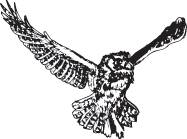

Snowy Owl
(Bubo scandiacus)
Snowy owls are a large and heavy raptor with a wing-span exceeding 5 feet and weighing as much as 4 1/2 pounds. It is North America's heaviest owl.
Males can be pure white, while females and juveniles have some dark markings. Most of the body feathers of the female are liberally barred with dark brown or black. Their eyes are golden and they have small feather tufts that are usually not visible.

Snowy owls nest on the tundra of northern Canada and Alaska. They breed on the treeless and mostly flat tundra, where the vegetation includes lichens, grasses, small flowering plants and dwarf shrubs.
Breeding and clutch size closely track lemming abundance. Years when lemmings are scarce, they do not breed or have a smaller clutch of eggs. Snowy owls build very simple nests on the ground of the Arctic tundra.
The female scrapes a round, shallow pit on top of a mound or small hill. She usually lays from 5-to-8 white or cream-colored eggs. The male feeds the incubating female and defends the nest.
The eggs hatch asynchronously: The first eggs hatch several weeks before the last.
The owlets are white and fluffy at first. In a few days, they turn a darker color. At this time, they look a little like ugly ducklings with their dark-gray downy feathers. The dark down color is especially useful in the cold to keep the young warmer.
There are many natural hazards which reduce the clutch size. Because of the difference in their ages/sizes, the female has a difficult time protecting all of her offspring. At times, some wander away from the nest. The cold and rainy weather kill many of the owlets. Only one brood of young is raised in a season. Families remain together at least into autumn.
When an intruder approaches the nest, both parents perform distraction displays. They leave the nest and walk toward the intruder, while beating their wings, trailing and dragging their wings, or raising and waving them.
Snowys almost always face the sun when roosting. Their breasts will gleam a white or slightly yellowish hue, creating a brilliant reflection.
During the Arctic summers, the sun shines almost all day long. Snowy owls are largely diurnal on their breeding grounds. In southern regions, in winter, they are usually crepuscular and are often active during some portion of the night.
Lemmings, voles and waterfowl are major prey species of snowy owls. Still-hunting, by watching for prey from an elevated perch is used most often. The Snowy Owl rivals the Great Horned Owl in ferocity, vigor and skill in hunting its prey.
In winter, the males are usually nomadic while the females are territorial, maintaining their territory with combination of vocal and visual displays. In some years, there are major migrations of Snowy Owls into southern Canada and the northern United States. These migrations usually occur at intervals of about 3-5 years, coincidentally with cyclic declines in lemming populations. Immature males winter farthest south, and adult females the farthest north. Snowy owls often land at airports because the big, open fields remind them of the tundra.
Most of the Snowy Owl's breeding range places it well out of contact with humans and its overall status is thought to have changed little in North America. In Europe, it is believed to have generally decreased, perhaps as a reflection of long-term climatic trends.
Many Snowy Owls have been shot by duck hunters during the winter. Some hunters see them as enemies of "their" game animals, or simply as something to mount for display on their mantel. In 1926-27, a massive invastion of Snowy Owls occurred and some 5,000 owls were shot that winter. Massive invasions southward also occurred during the winters of 1945-46 and 1966-67. Like all birds of prey, Snowy Owls are protected by international laws.